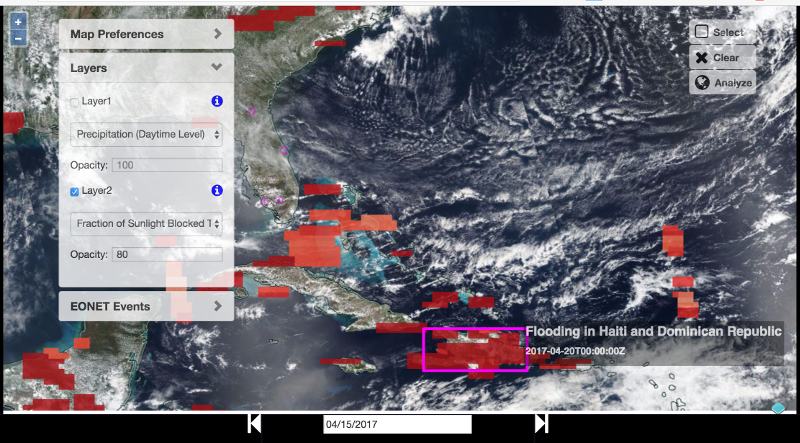Chicago | Every Cloud
Awards & Nominations
Chicago has received the following awards and nominations. Way to go!
The Challenge | Every Cloud
Silver Lining
An online visualization of aerosols and weather patterns, and a back-end framework for statistical analysis.

Silver Lining is an online visualization that allows viewers to overlay a world map with different layers of data, such as the amount of various aerosols, the intensity of weather patterns, and the concentration of greenhouse gases. It can also render natural event data from NASA Earth Event Natural Tracker ( EONET) to provide cues about where and when significant natural events have occurred.
The goals of the front end to explore data were simplicity and flexibility. The user can display choose whether or not to display the base image, coastlines, labels, and grid lines. S/he can also choose one or two relevant layers to display, control the opacity, and use a date picker to navigate to a particular point in time. For example, if EONET indicates that there was a severe storm at a particular point in time, it might be interesting to navigate to the time around the storm and view layers involving precipitation.
Through viewing these various layers and the extent to which they overlap, the viewer can better understand trends in aerosol distribution and how these may affect weather patterns and extreme weather events. For example, there was flooding in Haiti and the Dominican Republic on April 20, 2017. But when we explore an aerosol measure (albedo scatter) in the same area on April 15, five days before the flooding, we also see elevated values. Screenshots are at https://docs.google.com/document/d/1G6jxwe8VIa0yMy... .
The project also includes a back-end statistical framework that allows the viewer to select an area on the map, one or two layers, and a date for spatial analysis (autocorrelation) on the designated data. The analysis will be done on the back-end, using open source GIS tools, e.g. GRASS and QGIS.
The goal of this project is to allow people who are not domain experts to better understand the strength of the correlations and relationships between aerosols and weather. However, this tool could be generalized in the future to support exploration of relationships between other kinds of NASA data.
Spatial analysis can be computing-intensive and one team member has been working to build a cluster from low-priced computing boards ( Odroid C2s). One future possibility for this kind of work would be linking an user-friendly front end like the one developed for this project to high-performance computing (HPC) resources. That could allow students who didn't know much about GIS or HPC to perform sophisticated and interesting computations.
Our codebase is available at https://github.com/SpaceAppsChicago2017/ and has an open source license. The front end can be viewed at https://spaceappschicago2017.github.io/EveryCloud/ A PowerPoint presentation about statistical analysis to detect severe weather is at https://drive.google.com/open?id=0B9XSTTsWJxMaUTlh...
Check out our cover page at https://neikorivera.github.io/EveryCloudCoverPage/ !
Resources used include the following:
- Github
- Amazon web services
- NASA WMTS (GIS) servers
- NASA EONET
- JavaScript JQuery
- QGis
- Python
- Google Docs
SpaceApps is a NASA incubator innovation program.